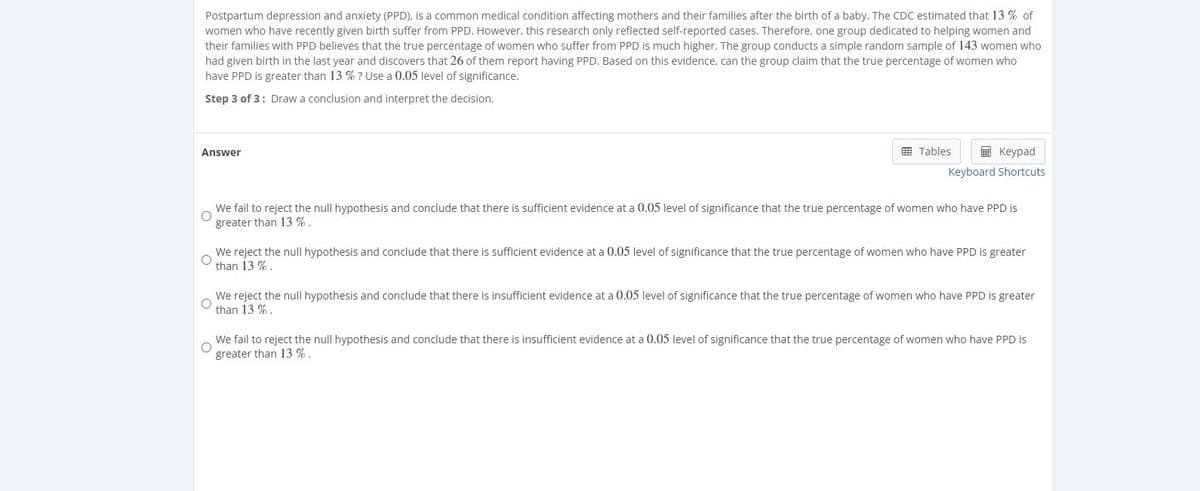Postpartum depression and anxiety (PPD), is a common medical condition affecting mothers and their families after the birth of a baby. The CDC estimated that 13 % of women who have recently given birth suffer from PPD. However, this research only reflected self-reported cases. Therefore, one group dedicated to helping women and their families with PPD believes that the true percentage of women who suffer from PPD is much higher. The group conducts a simple random sample of 143 women who had given birth in the last year and discovers that 26 of them report having PPD. Based on this evidence, can the group claim that the true percentage of women who have PPD is greater than 13 % ? Use a 0.05 level of significance. Step 3 of 3: Draw a conclusion and interpret the decision. Answer Tables кеурad Keyboard Shortcuts We fail to reject the null hypothesis and conclude that there is sufficient evidence at a 0.05 level of significance that the true percentage of women who have PPD is greater than 13 %. We reject the null hypothesis and conclude that there is sufficient evidence at a 0.05 level of significance that the true percentage of women who have PPD is greater O than 13 %. We reject the null hypothesis and conclude that there is insufficient evidence at a 0.05 level of significance that the true percentage of women who have PPD is greater than 13 %. We fail to reject the null hypothesis and conclude that there is insufficient evidence at a 0.05 level of significance that the true percentage of women who have PPD is greater than 13 %.
Postpartum depression and anxiety (PPD), is a common medical condition affecting mothers and their families after the birth of a baby. The CDC estimated that 13 % of women who have recently given birth suffer from PPD. However, this research only reflected self-reported cases. Therefore, one group dedicated to helping women and their families with PPD believes that the true percentage of women who suffer from PPD is much higher. The group conducts a simple random sample of 143 women who had given birth in the last year and discovers that 26 of them report having PPD. Based on this evidence, can the group claim that the true percentage of women who have PPD is greater than 13 % ? Use a 0.05 level of significance. Step 3 of 3: Draw a conclusion and interpret the decision. Answer Tables кеурad Keyboard Shortcuts We fail to reject the null hypothesis and conclude that there is sufficient evidence at a 0.05 level of significance that the true percentage of women who have PPD is greater than 13 %. We reject the null hypothesis and conclude that there is sufficient evidence at a 0.05 level of significance that the true percentage of women who have PPD is greater O than 13 %. We reject the null hypothesis and conclude that there is insufficient evidence at a 0.05 level of significance that the true percentage of women who have PPD is greater than 13 %. We fail to reject the null hypothesis and conclude that there is insufficient evidence at a 0.05 level of significance that the true percentage of women who have PPD is greater than 13 %.
Holt Mcdougal Larson Pre-algebra: Student Edition 2012
1st Edition
ISBN:9780547587776
Author:HOLT MCDOUGAL
Publisher:HOLT MCDOUGAL
Chapter11: Data Analysis And Probability
Section11.4: Collecting Data
Problem 2E
Related questions
Question

Transcribed Image Text:Postpartum depression and anxiety (PPD), is a common medical condition affecting mothers and their families after the birth of a baby. The CDC estimated that 13 % of
women who have recently given birth suffer from PPD. However, this research only reflected self-reported cases. Therefore, one group dedicated to helping women and
their families with PPD believes that the true percentage of women who suffer from PPD is much higher. The group conducts a simple random sample of 143 women who
had given birth in the last year and discovers that 26 of them report having PPD. Based on this evidence, can the group claim that the true percentage of women who
have PPD is greater than 13 % ? Use a 0.05 level of significance.
Step 3 of 3: Draw a conclusion and interpret the decision.
Answer
囲 Tables
国 Keypad
Keyboard Shortcuts
We fail to reject the null hypothesis and conclude that there is sufficient evidence at a 0.05 level of significance that the true percentage of women who have PPD is
greater than 13 %.
We reject the null hypothesis and conclude that there is sufficient evidence at a 0.05 level of significance that the true percentage of women who have PPD is greater
than 13 %.
We reject the null hypothesis and conclude that there is insufficient evidence at a 0.05 level of significance that the true percentage of women who have PPD is greater
than 13 % .
We fail to reject the null hypothesis and conclude that there is insufficient evidence at a 0.05 level of significance that the true percentage of women who have PPD is
greater than 13 %.
Expert Solution
This question has been solved!
Explore an expertly crafted, step-by-step solution for a thorough understanding of key concepts.
Step by step
Solved in 4 steps

Recommended textbooks for you

Holt Mcdougal Larson Pre-algebra: Student Edition…
Algebra
ISBN:
9780547587776
Author:
HOLT MCDOUGAL
Publisher:
HOLT MCDOUGAL

College Algebra (MindTap Course List)
Algebra
ISBN:
9781305652231
Author:
R. David Gustafson, Jeff Hughes
Publisher:
Cengage Learning


Holt Mcdougal Larson Pre-algebra: Student Edition…
Algebra
ISBN:
9780547587776
Author:
HOLT MCDOUGAL
Publisher:
HOLT MCDOUGAL

College Algebra (MindTap Course List)
Algebra
ISBN:
9781305652231
Author:
R. David Gustafson, Jeff Hughes
Publisher:
Cengage Learning
